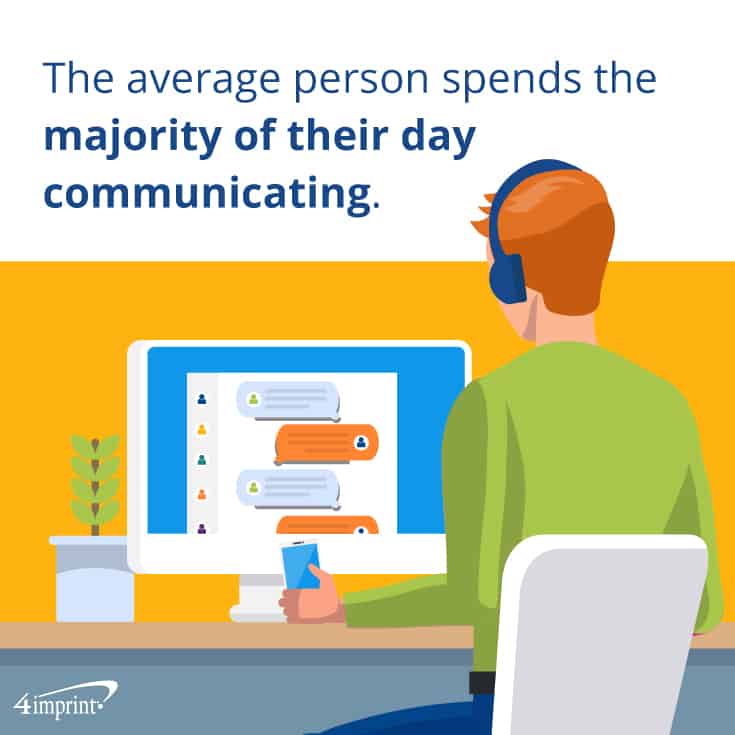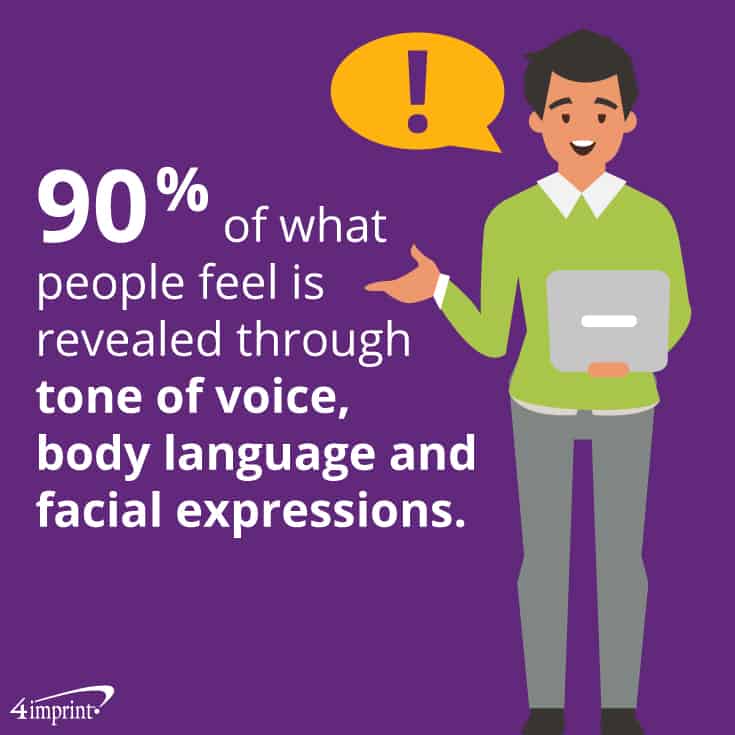It might sound strange, but studies show that people need to be taught how to listen. The average person spends the majority of their day communicating, and roughly 40 percent of that time is spent listening.

With all that practice, how could we be doing it wrong?
A recent 4imprint® team-building study showed that effective listening is one of the three most common team-training topics, along with communication and goal setting. Moreover, training for effective listening is on the rise, with 39 percent of companies providing it. That’s up from 37 percent a year ago.
In this Blue Paper, we’ll define what effective listening looks like. We’ll also provide simple methods to sharpen your employee’s active listening skills. And, we’ll talk about how training giveaways and practice have helped our customers improve their businesses.
Levels of listening
Before we dive into the benefits of effective listening, it’s helpful to understand the levels of listening and how they affect communication:
Listening to speak: Here, the listener is concentrating on what they are going to say rather than on what the other person is saying.
Listening to hear: This occurs when the listener has a high interest in the topic or speaker. They are fully focused on the words being spoken.
Listening to understand: At this level, the listener is not just focused on the words the speaker is using, but the meaning behind the words. Listeners are also paying to attention to how the words are being conveyed via body language and tone of voice.
As a listener gets better at moving through these levels, understanding and communication improves significantly.
How understanding improves your business
Because effective listening is based on understanding what the listener is saying, using it has a number of benefits for your company:
Fewer misunderstandings
Once they learn to listen effectively, it’s easier for employees to discover their knowledge gaps. When they realize they don’t understand something, they’ll ask better clarifying questions. That will help them more fully grasp how to proceed with processes, procedures and projects.
Better employee retention
When employees know they’re being heard, they’re more likely to stay with the company. Active listening helps develop a bond of empathy. And, 92 percent of employees feel more inclined to stay with a company that demonstrates empathy.
Greater productivity with fewer do-overs
Whether learning about new procedures, new equipment or a new project, effective listening can help save time and frustration. Here’s a few examples of how:
- Knowing how to use new equipment can prevent accidents and mistakes that lead to projects being redone.
- Understanding roles in a new project can prevent repeat questions about items that have already been explained.
- Knowing the why and how of each new procedure can save valuable time that might instead have been spent on re-training.
Better listening makes better customer relations
Effective listening doesn’t just improve the employer-employee relationship, it can also have a powerful effect on employee-customer relationships. One study found 68% of consumers were highly influenced by sellers who listened well.

Marie Ackerman can attest to that. She is a seminar coordinator for Federal Employees First Alliance (FEFA) ,a St. Louis, Mo.-based company that helps federal employees who are about to retire. The company recently brought in all 50-plus employees for a weeklong training session.
“We do a lot of talking on the phone, so a lot of what we were learning was about how to proceed with the first call, the second call, the third call and so on,” Ackerman said.
Part of knowing how to talk to customers is understanding how to listen to them. “When you’re helping someone plan for retirement, you have to listen to them to know what they do in retirement. You have to really know the client to guide them and what’s best for them and what they want to do. Do they want to travel? How old are they now and when are they thinking about retiring?” Ackerman said.
The training has led to big rewards—for the company and their clients. As more of their clients look forward to retirement, FEFA has more employee workshops planned.
Getting to know their clients even helped FEFA pick out the perfect team-building gifts to catch attention during in-person meetings. Everyone at the training got a USA Made Bottom Gusset Tote filled with branded swag, a perfect American-made gift for union-member clients.
How to perform effective listening
Now that we’ve shown how useful active listening can be, let’s talk about what effective listening looks like. Inc. magazine lays out a few simple steps to get you started.
Focus on the speaker
One of the biggest challenges of fully listening to someone is eliminating both external and internal distractions. It’s not just about setting down a smartphone. It’s about setting aside whatever is on your mind and devoting your full attention to the person who is speaking.
How do you show the speaker you’re focusing on them?
- Maintain eye contact and lean toward the speaker.
- Encourage the person to continue speaking with nods and affirmations, but otherwise avoid speaking.
- Avoid forming a response while you’re listening.
Interpret what they’re saying
Watching for nonverbal cues is essential to effective listening. Ninety percent of what people feel is revealed through tone of voice, body language and facial expressions. Taking in both the words and the emotion behind the words can help improve listeners’ understanding.

Summarize and confirm your understanding
Once the speaker is finished, tell them your understanding of what they said. Draw attention to anything their body language is telling you that their words might not be. For example, “You stated that this issue doesn’t upset you, but your tone of voice tells me that you’re angry. Are you angry?”
Ask questions and confirm what the speaker needs from you. Are they seeking advice? Do they require a solution to their problem? Did they just need to be heard?
Training methods
Although using steps like the ones above will help you to become a more effective listener, like most things in life, practice makes perfect.
Gail Harris knows that first-hand. She’s a workforce development administrative assistant at INEOS O&P USA, a manufacturer of olefins and polymers. A few years ago, the company recognized that with pending retirements, frontline leaders might need some additional training.
The company held a series of workshops on various management topics, including effective listening. “Not only do they do receive a lecture on the topic, they also do role-playing. It’s interactive and lets them get some practice with their peers,” Harris said. “They do it in a large group, with everyone in their group sitting at the table so everyone can listen and learn from one another. It takes a lot of practice for people to really learn how to hear one another, and not just listen to answer.”
At each quarterly training session, they pass out practical training giveaways, such as a Sticky Book, with a special leadership logo on it that says, “Foundation. Leadership. Legacy.”
The team-building gifts also have an unexpected use. “We have 13 groups, and each group comes once a quarter for training,” Harris said. “They get a product at each training and have become quite popular. I have heard people say, ‘I didn’t get one of those mugs.’ It’s a good reminder when someone missed a module and has to take a catch-up course!”
Ideas you can use
If you’re looking for ways to allow your staff to practice their listening skills, consider trying out one of these simple, fun exercises:
- Distracted listeners: Break into two groups. People from group A must talk about something that interests them, while people from group B must act distracted by looking out the window or putting their hand up each time they want to interrupt. Have the A group discuss how they felt during the exercise.
- Vacation sales: Divide the group into pairs. Have one person describe a vacation they would like to take without naming a specific destination. After five minutes, the second person discusses the most important factors about possible vacation spots and determines where the first person might enjoy vacationing. After that, spend a few minutes discussing what important points the listener may have missed. Then have the pair switch roles.
- Round robin discussion: Tell the group you’re going to discuss a topic they all have some information about, like your company or products. The first person starts talking, and when you say, “Stop,” the next person must repeat the last few words the previous speaker said, and then continue talking about the topic. Start by having people go in order. Then try the same exercise again, calling on random people in the room to continue discussing the topic. This will cause everyone to pay closer attention, since they can be called on at any time.
Better listening creates better businesses
With so many benefits, effective listening is a growing part of team training. And with a little practice and training giveaways, you can help your customers and your employees feel heard.

